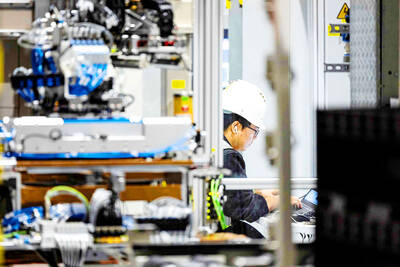Taiwan Semiconductor Manufacturing Co (TSMC, 台積電) yesterday posted its weakest quarterly net profits in about four-and-half years, largely due to flagging demand for premium smartphones and customers’ inventory corrections.
TSMC’s net profits plunged 31.6 percent to NT$61.39 billion (US$1.99 billion) in the quarter ending on March 31, compared with NT$89.79 billion in the same period last year.
That represents a decline of 38.6 percent from NT$99.98 billion in the previous quarter.
The result fell short of analysts’ expectations, as Credit Sussie Group AG’s had forecast NT$62.11 billion, while Citigroup Market Inc had said NT$61.6 billion.
The Hsinchu-based company, which is the sole chip supplier to Apple Inc’s iPhone X series, said the worst was over and it expected a strong rebound in the second half of this year, buoyed mainly by chips used in clients’ new high-end smartphones, as well as those for the initial deployment of 5G and high-performance-computing applications.
Those applications would boost demand for its 7-nanometer chips and improve its factory utilization, reversing the overcapacity expected in the first half of the year, TSMC said.
“Moving into the second quarter of this year, while economic factors and mobile product seasonality still linger, we believe we might have passed the bottom of cycle of our business,” chief executive C.C. Wei (魏哲家) told an investors’ conference. “We are seeing customers’ demand stabilizing.”
TSMC said it expects customers to reduce inventory substantially to approach the seasonal level in the middle of this year.
For the whole year of this year, TSMC still expects a “slight” growth in revenue from last year’s NT$1.03 trillion, Wei said.
That compares with the zero growth estimate given for the worldwide semiconductor industry, excluding the memorychip sector.
Smartphone platform and HPC platforms, two of the company’s major product categories, were expected to grow at a high-single-digit percentage this year, excluding cryptocurrency chips, Wei said.
“We are gaining market share along with our [smartphone] customers,” Wei said. “Silicon content for high-end smartphones is also on the rise.”
HiSilicon Technologies Co (海思半導體), the chip designing arm of China’s Huawei Technologies Co Ltd (華為), is one of TSMC’s top clients.
With 15 percent market share worldwide, Huawei saw its ranking move up one notch last quarter to become the world’s No. 2 smartphone vendor, from third place in the fourth quarter of last year, market researcher TrendForce Corp’s (集邦科技) ranking showed.
For this quarter, TSMC expects revenue to grow about 7 percent to between US$7.55 billion and US$7.65 billion, compared with NT$218.7 billion last quarter.
The growth is largely attributable to wafer shipments, which last quarter were affected by a problem in February with the photoresist material used in wafer production.
Gross margin is to improve to between 43 percent and 45 percent this quarter from 41.3 percent last quarter, the chipmaker predicted.
It is still aiming for 50 percent growth in gross margin for the second half of this year and in the long run, the company said.
TSMC kept its capital spending for this year unchanged at a range between US$10 billion and US$11 billion.

CHIP RACE: Three years of overbroad export controls drove foreign competitors to pursue their own AI chips, and ‘cost US taxpayers billions of dollars,’ Nvidia said China has figured out the US strategy for allowing it to buy Nvidia Corp’s H200s and is rejecting the artificial intelligence (AI) chip in favor of domestically developed semiconductors, White House AI adviser David Sacks said, citing news reports. US President Donald Trump on Monday said that he would allow shipments of Nvidia’s H200 chips to China, part of an administration effort backed by Sacks to challenge Chinese tech champions such as Huawei Technologies Co (華為) by bringing US competition to their home market. On Friday, Sacks signaled that he was uncertain about whether that approach would work. “They’re rejecting our chips,” Sacks

NATIONAL SECURITY: Intel’s testing of ACM tools despite US government control ‘highlights egregious gaps in US technology protection policies,’ a former official said Chipmaker Intel Corp has tested chipmaking tools this year from a toolmaker with deep roots in China and two overseas units that were targeted by US sanctions, according to two sources with direct knowledge of the matter. Intel, which fended off calls for its CEO’s resignation from US President Donald Trump in August over his alleged ties to China, got the tools from ACM Research Inc, a Fremont, California-based producer of chipmaking equipment. Two of ACM’s units, based in Shanghai and South Korea, were among a number of firms barred last year from receiving US technology over claims they have

It is challenging to build infrastructure in much of Europe. Constrained budgets and polarized politics tend to undermine long-term projects, forcing officials to react to emergencies rather than plan for the future. Not in Austria. Today, the country is to officially open its Koralmbahn tunnel, the 5.9 billion euro (US$6.9 billion) centerpiece of a groundbreaking new railway that will eventually run from Poland’s Baltic coast to the Adriatic Sea, transforming travel within Austria and positioning the Alpine nation at the forefront of logistics in Europe. “It is Austria’s biggest socio-economic experiment in over a century,” said Eric Kirschner, an economist at Graz-based Joanneum

France is developing domestic production of electric vehicle (EV) batteries with an eye on industrial independence, but Asian experts are proving key in launching operations. In the Verkor factory outside the northern city of Dunkirk, which was inaugurated on Thursday, foreign specialists, notably from South Korea and Malaysia, are training the local staff. Verkor is the third battery gigafactory to open in northern France in a region that has become known as “Battery Valley.” At the Automotive Energy Supply Corp (AESC) factory near the city of Douai, where production has been under way for several months, Chinese engineers and technicians supervise French recruits. “They